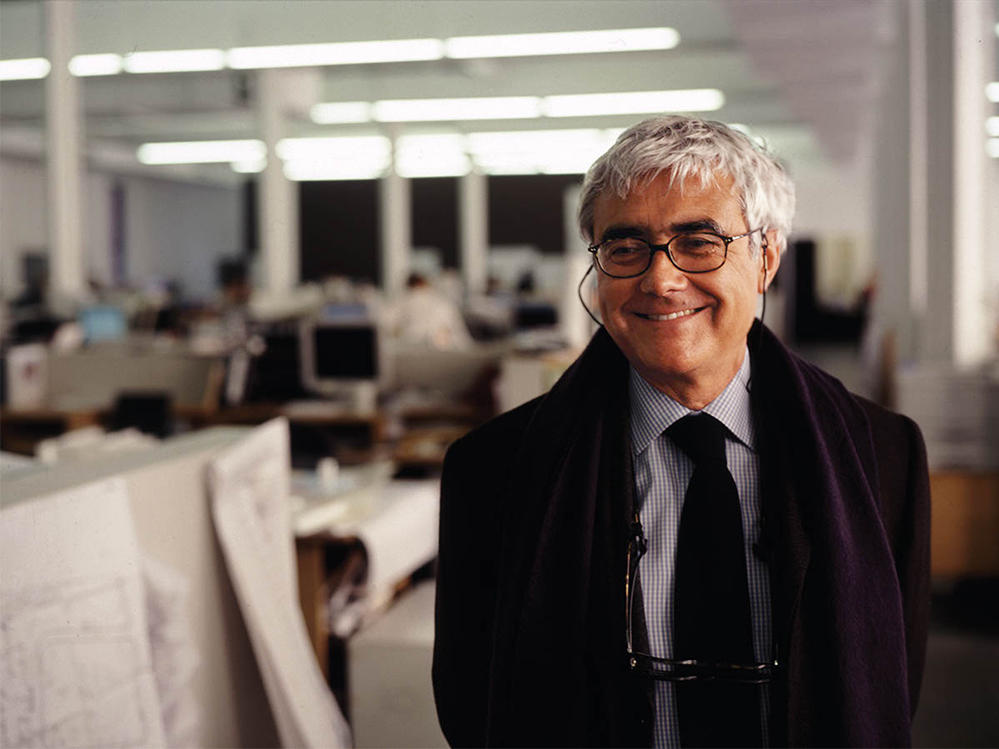Section Branding
Header Content
Rafael Viñoly, the architect behind the 'Walkie-Talkie' building, has died
Primary Content
Rafael Viñoly, a Uruguayan-born architect whose award-winning modernist buildings bring a dramatic flair to skylines around the world, has died. He was 78.
Viñoly died of an aneurysm at New York's Presbyterian Hospital in Lower Manhattan on Thursday, according to his firm.
"I am saddened to report that my father, the founder and namesake of our firm Rafael Viñoly Architects, passed away unexpectedly," his son and collaborator Román Viñoly wrote in a statement. "He was a visionary who will be missed by all those whose lives he touched through his work."
His most recognizable works include the Tokyo International Forum, the Cleveland Museum of Art, the Carrasco Airport in Montevideo, and 20 Fenchurch Street in London — better known as the "Walkie-Talkie" building.
Viñoly, whose civic and cultural buildings were the backbone of his portfolio, was preoccupied with the practical use of his structures.
"He bears a professional affinity for the nerdy, workmanlike challenges of designing complex institutional architecture: hospitals, a nanosystems institute, a cancer research centre," said John Gravois, writing for the UAE's The National in 2010. "His buildings often seem designed not to be photographed from the air but to be used and experienced — from both the inside and out. And he displays the distinctly unstar-like habit of designing structures that respect their neighbours."
Some of his buildings, however, have drawn criticism for being unneighborly.
Viñoly designed the infamous "Walkie-Talkie" tower in London's financial district, a bulbous building whose concave glass facade melted at least one nearby car with its reflection in 2013.
Viñoly later explained the design flaw as the result of a development process that he said casts aside the architect.
"One problem that happens in this town, is the super-abundance of consultancies and sub-consultancies that dilute the responsibility of the designer," he told The Guardian, "to the point that you just don't know where you are any more."
Another Viñoly building, New York's skinny skyscraper, 432 Park Avenue — once the world's tallest residential building at almost 1,400 feet — made headlines for what critics saw as a blight on Manhattan's skyline. Residents of the luxury apartments faced a spate of construction and engineering problems, including leaky plumbing, creaky walls and faulty elevators.
The architect outwardly rejected a fame-seeking approach he saw as endemic among contemporary architects.
"I'm very interested in unglamorousness!" he said in a Q&A with Metropolis in 2010. "If you remember, 10, 15 years ago, if you weren't working on a museum you weren't an architect. With hospitals, that level of snobbism would never have been applicable — nobody gives a royal screw about that stuff."
Even as he distanced himself from the role of "architect as glamour oracle," Gravois wrote in The National, Viñoly "does not appear to shrink from being a larger-than-life, media-ready personality, or from making oracular pronouncements."
Born in 1944 in Montevideo, Uruguay, Viñoly became a founding partner of prominent Argentina-based design studio Estudio de Arquitectura at age 20, according to his firm's biography. In 1978, Viñoly moved to the U.S. and landed a job as a guest lecturer at the Harvard University Graduate School of Design, and settled in New York the following year. In 1983, Viñoly founded Rafael Viñoly Architects, a New York City-based firm with offices in London, Manchester, Abu Dhabi, Buenos Aires, Chicago and Palo Alto.
In addition to his son Román, he is survived by his wife Diana, his stepsons Nicolás and Lucas, and his brother Daniel, his company said.
Copyright 2023 NPR. To see more, visit https://www.npr.org.

